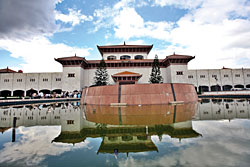 KIRAN PANDAY |
The first scenario is that despite the hiccups, it all works out in the end.
This would either mean that the Maoists start cooperating with this government, the Maoists lead a national government, or all parties strike a power-sharing deal and accept a consensus candidate. A broad package deal is then arrived at. And in the first few months of 2010, cutting short the time for public consultations, ignoring opposition from some quarters, a statute is pushed through.
For this to happen, there needs to be a dire sense of urgency across the political spectrum. Common fears--of losing their relevance, of the process collapsing, of inviting unmanageable risks--would have to drive parties to work together.
Most would consider this outlook unlikely. What could change for the parties to suddenly end up cooperating in a month or two? Will the increasingly violent Maoist agitation drive home the point about their indispensability and force a deal, or will it invite a backlash? Can GPK act ahead of his party and strike a deal with the Maoists? Do key actors within the Maoists and the NC even want a change in government before their respective conventions in January
and March?
And if we have to wait that long for a political agreement, won't we miss the May deadline anyway? How does the desire of the NC-UML to do away with the PLA before the constitution is written square with the seeming determination of the Maoists to keep the PLA till the constitution is written? Can contentious claims on federalism be reconciled in such a short time-frame?
This brings us to the second, more likely scenario: the May deadline will be missed.
If the big parties strike a power-sharing deal, and if the deadline is missed only because of constitutional issues, they may all get together, amend the constitution, give themselves an extension, and fulfill their mandates. But if confrontation has deepened and constitutional debates have further polarised politics, then we are stuck.
Article 64 (on the term of the CA) of the interim constitution is typical of ambiguous Nepali legalese. It seems to suggest that the CA can extend its tenure by six months in case the constitution has not been written because of the declaration of a state of emergency. Does this mean an extension can be justified only in the event of a formal emergency? What if the extension is necessary because of other factors?
Article 143 (emergency powers) states that the president, on the recommendation of the council of ministers, can impose a state of emergency. But this has to be approved by two thirds of the legislature-parliament within a month of its imposition. This means there has to be broad, sustained political consensus on the legitimacy of such a move, even if it does not exist when the declaration is made.
Either way, we are getting into very tricky politico-legal territory.
The role of the president will be important. Many forces would like to lure the President into an extra-constitutional step. The yearning for political order might then only provide further impetus to a drastic move.
That is why there is a need for a constitutional amendment now. This will give the Maoists a face-saver, allow discussion of President Yadav's move, and break the House stalemate. More importantly, an amendment that defines and limits the presidential role will be critical for the rest of this transitional period (especially if we extend the CA's tenure).
To make it more even-handed, and take into account criticisms of how Prachanda handled the Katawal affair, the amendment could state that only governments commanding a majority can make binding recommendations on the head of state. It could also clarify the president's options if he is unsure of the government's support.
All these issues will be clarified in the future constitution. But we need to take care of the short term, too, or next May could be more dangerous than the last.



